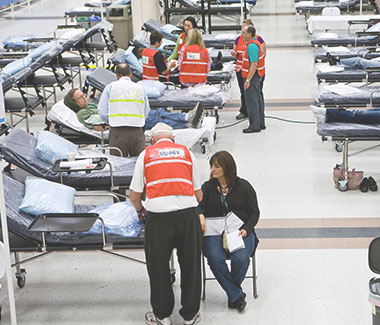

Earthquakes get a lot of attention in the Pacific Northwest, and for good reason: they pose a serious threat to our region. The response tactic of ‘drop, cover and hold’ is ingrained in us from an early age, yet we are impacted by a sizable earthquake only once or twice in our lifetime. A quick peak at news headlines tells us there are many more disruptive events to consider preparing for, but where should we focus our efforts?
Platform for Preparedness
For any community, knowing its vulnerabilities and risks is the foundation for developing emergency plans and drives preparedness and response activities. For most healthcare organizations, with their specialized environments, staff and equipment, considerable thought must be given to the hazards on which they base their preparedness plan. The stakes are high: the objective is to ensure they can provide the highest level of care and safety possible for patients and healthcare workers during an emergency.
- Vulnerability: Weaknesses or gaps
- Threat: Anything that negatively impacts a community, via a vulnerability, either intentionally or accidentally
- Risks: The potential for loss, damage or destruction as a result of a vulnerability
Many healthcare organizations are required to base their emergency preparedness plan on an ‘all-hazards’ risk assessment, covering epidemic/pandemic, biological, chemical, nuclear/radiological, explosive-incendiary and national incidents, but must also consider local threats.
The Northwest Healthcare Response Network (the Network) took on the challenge of creating the state’s first Regional Healthcare Hazard Vulnerability Assessment ,specifically to assist the Puget Sound region’s healthcare organizations with their plans.
First, representatives from the healthcare community were pulled together — almost half of which had over twenty years of professional experience — including hospitals, outpatient clinics, administration, engineering, safety, supply chain, public health, environment of care and emergency medical services. Led by the Network, this robust group embarked upon identifying, verifying and prioritizing hazards with expert input from healthcare emergency preparedness leaders.
Developing a Hazard Vulnerability Assessment
Round one of the process started with an analysis of potential hazards identified by five state and local government HVAs. Based on the data in these assessments, Network staff designated a low, medium or high likelihood of occurrence to 21 hazards and 14 sub-hazards, with the likelihood being based on historical frequency and statistical probability.
Next, project participants were asked to assess potential impacts of a winnowed-down pool of 28 hazards in four general categories: public health and safety; property, facilities and infrastructure; economy; and other. In assessing the impacts, they considered the level of disruption and ability of the healthcare community to provide essential services. The 12 participants reached consensus on 24 hazards, such as ‘Severe Weather (Storm)’, which was given a moderate rating in likelihood and high rating in impact, placing it in the high hazard matrix category.
Round two involved gathering input from an additional pool of 42 participants, 71 percent of whom had previously participated in an organizational or regional HVA process. Of the 28 hazards, 12 reached consensus. While this total is half the consensus total of the first round, all hazards surveyed in round two reached at least 50% agreement on their regional healthcare impact, with several narrowly missing the 75% ‘consensus’ definition. Furthermore, the ranking of impact for all hazards in round two corresponded exactly to the same rank in round one.
Based upon the two survey rounds of the HVA project, there was clear agreement on which threats should be considered the most ominous; nine assessed hazards were categorized with at least a moderate likelihood and moderate healthcare impact category. Those nine hazards, in alphabetical order, are:
- Earthquake
- Geomagnetic storm
- Health (epidemic, pandemic)
- Power outage (regional)
- Technology threats
- Severe weather (storm)
- Terrorism (small)
- Terrorism (large)
- Volcano
This powerful planning tool is now available to Network members and partners. They will reference it as they develop their own facilities’ hazard vulnerability assessments.
For a copy of the full HVA and supporting documents, please contact the Network at 425.988.2898.
returnOther Impact Stories

Impact Focus:
Multi-Agency Coordination
Ensuring Capacity...
The Challenge At least 25% of the population of the state of Washington is a pediatric patient, specifically under the… Read more »

Impact Focus:
Evacuation
Partnerships and...
Challenge: Relocating 77 vulnerable residents from a skilled nursing facility in rural Washington during a fire evacuation emergency. Montesano, Washington… Read more »

Impact Focus:
Situational Awareness
Extreme Heat...
The Network spearheads coordination and collaboration to save lives during an extreme heat response. In late June 2021, amidst a… Read more »
